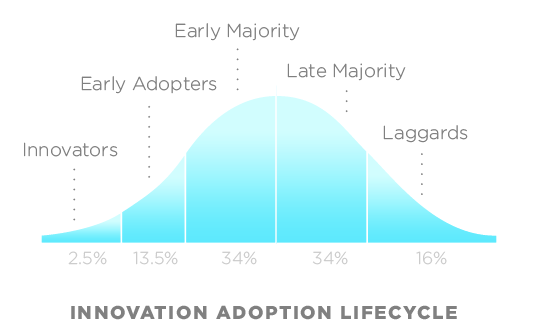Crossing the Innovation Adoption Gap with Life Cycle Assessment
Innovation reshapes our world, leading to groundbreaking products and services that revolutionize industries and improve lives. However, not all innovative ideas successfully make their way into the mainstream market, with one of the critical challenges faced by innovators being the so-called ‘innovation adoption gap.’
To overcome this hurdle and ensure a smooth transition from early adopters to the early majority, innovators can leverage Life Cycle Assessment (LCA) as a powerful tool. In this article, we explore the Diffusion of Innovations law, the Chasm Theory, and how LCA can help bridge the gap, driving the successful adoption of innovation.
The Diffusion of Innovations Theory
Popularized by Everett Rogers in 1962, the Diffusion of Innovations theory describes how new ideas, technologies, or products spread within a social system. Rogers identified five adopter categories within this process: innovators, early adopters, early majority, late majority, and laggards. The theory highlights the importance of understanding the dynamics of innovation adoption and the different factors influencing each group.

Innovators
Innovators are the pioneers of the adoption process. They represent a small percentage of the population but play a crucial role in the initial acceptance of new ideas or technologies. Innovators are characterized by their adventurous and risk-taking nature. They are always on the lookout for the latest innovations and are eager to try them out, even if they may not be fully refined or proven. They possess a high level of technical expertise and see the potential impact of new ideas.
Innovators are willing to tolerate potential drawbacks or failures in exchange for the excitement of being the first to experiment with something novel. They often serve as influencers and opinion leaders in their social circles, sharing experiences and directing the opinions of others. Innovators’ enthusiasm and endorsement can be vital in gaining momentum for an innovation’s early stages.
Early Adopters
The early adopters are the second wave of individuals to adopt innovations. They tend to be more thoughtful and discerning than the innovators, carefully observing the experiences of the innovators before making their own decisions. Early adopters share some common traits with innovators, such as a higher level of education and a propensity for risk-taking, but they are not as willing to embrace unproven or radical ideas.
One of the defining characteristics of early adopters is their ability to see the potential benefits of an innovation and envision how it can address specific problems or fulfill particular needs. Their willingness to embrace change and their influence within social networks make them important bridge-builders between innovators and the early majority. They often serve as advocates and provide testimonials on the value of the innovation, which can significantly impact its broader adoption.
Early Majority
The early majority represents one of the largest adopter categories and plays a pivotal role in the innovation diffusion process. Unlike innovators and early adopters, the early majority is more risk-averse and pragmatic in adopting new ideas or technologies. They observe how innovations fare in the market and are influenced by the experiences of both early adopters and the broader population.
For the early majority, the key driver for adoption is the demonstration of real-world benefits and evidence of an innovation’s practical value. They seek solutions that have been tested and validated, and they are less willing to embrace unproven or uncertain innovations. This group often comprises the critical numbers necessary for an innovation to reach mainstream acceptance.
Late Majority
Late majority members tend to be more cautious and skeptical. They wait until most people have already adopted a particular innovation before embracing it themselves.
Late majority adopters are often influenced by social norms and peer pressure, feeling more comfortable adopting something that is widely accepted. They might be hesitant due to concerns about the complexity or potential risks associated with the innovation. To appeal to the late majority, innovators must address any remaining barriers and provide reassurance about the innovation’s reliability and benefits.
Laggards
Laggards are the final group in the adoption process, characterized by their strong resistance to change. They cling to traditional practices and are often skeptical of new ideas and technologies. Laggards are typically more conservative individuals who prefer familiar and established products or methods.
For laggards, adopting an innovation represents a significant departure from their comfort zone. They might only embrace an innovation when it becomes absolutely necessary or when there are no viable alternatives left. Due to their resistance to change, persuading laggards to adopt an innovation can be challenging.
The Chasm Theory
While the Diffusion of Innovations law provides insights into the adoption flow, Geoffrey Moore extended this model with his Chasm Theory, introduced in 1991.
The chasm represents a gap in the adoption process that occurs between the early adopters and the early majority. The early adopters are typically more technologically savvy, risk-tolerant, and open to embracing disruptive innovations. They are excited about new possibilities and are willing to try products that are not fully proven or optimized. On the other hand, the early majority, constituting the pragmatic and risk-averse segment of the market, is not as receptive to unproven or disruptive technologies. They need more evidence of an innovation’s viability and stability before considering adoption.
Crossing the chasm is one of the most significant challenges innovators face, as it requires adapting strategies and messaging to resonate with the needs and concerns of the early majority. Several factors contribute to the formation of the chasm:
Risk Aversion: The early majority is more risk-averse than early adopters, requiring greater assurance that an innovation will deliver the promised benefits with minimal disruption or failure.
Pragmatism: The early majority seeks practical solutions to real-world problems, and they value proven track records and established best practices.
Solution Maturity: Early majority customers prefer solutions that have been tested and refined, ensuring a smoother implementation process and fewer unexpected challenges.
Market Education: Early majority customers require clearer value propositions and a deeper understanding of how the innovation will address their specific pain points.
Moore’s theory advises innovators to focus on one customer group at a time, leveraging early adopters’ success to gain momentum for broader adoption. If a business manages to create a bandwagon effect, the innovation can become a de-facto standard by solving a critical problem in one specific vertical. Once established in one niche, the innovation can expand into related verticals, using its credibility to address similar challenges. Gradually, the innovation gains acceptance across different segments, eventually becoming the default choice for businesses facing the problem it solves. This sequential approach helps innovators bridge the adoption gap and achieve widespread market acceptance, positioning their products for long-term success and impact.
Leveraging Life Cycle Assessment & Product Lifecycle Management
Over the years, companies have been dedicated to adopting holistic product lifecycle management (PLM) systems. These systems encompass a range of business solutions that enable the seamless utilization of product definition data from inception to end use.
In contemporary times, PLM has become integral to engineers’ work, acting as their primary language. By leveraging PLM systems, companies can effectively capture, standardize, analyze, and disseminate product knowledge throughout their organizational structure.
Deloitte, one of the world’s leading providers of industry insights and audit, consulting, financial advisory, risk management, and tax services, cites the following tangible benefits that one of its clients realized upon implementing PLM:
Ernst & Young, another ‘Big Four’ firm, presented a compelling case study of a large company that witnessed remarkable improvements after fortifying its PLM and supply chain frameworks. The company experienced a noteworthy 40% increase in the net present value of its product portfolio, while resource productivity surged by over 20%. Additionally, the adoption of digital PLM yielded impressive gains, with project durations reduced by 10% to 30%, leading to a substantial acceleration in sales. Another company’s success story highlighted by EY involves embracing digital PLM, resulting in complete portfolio transparency and a remarkable 72% increase in gross margin per active product.
KPMG—also a member of the ‘Big Four’—successfully crafted a compelling business case for a product lifecycle management platform tailored for its client engaged in manufacturing Oil & Gas compression equipment and refinery technology. The project analysis highlighted the significant potential for revenue enhancement, estimating a remarkable 5 to 10 percent increase. Additionally, the implementation of the PLM platform was expected to yield substantial cost savings, with operational costs projected to decrease by 10 percent. This promising combination of revenue improvement and cost reduction presented a highly favorable outcome for the client’s business operations and overall profitability.
Optimizing product lifecycle management with a digital-focused approach enables organizations to mitigate a host of unfavorable outcomes, such as inefficiencies, slow turnaround times, and forecasting errors. Furthermore, this strategy helps prevent the accumulation of an extensive portfolio of low-value or low-profit products. By skillfully combining a digital strategy with state-of-the-art technologies like cloud computing, AI, and RPA, companies can foster innovative product design, development, and management, ensuring the delivery of superior quality throughout the entire product lifecycle.
Product Lifecycle Management (part of the broader Life Cycle Assessment) can also be invaluable in bridging the innovation adoption gap. Here’s how innovators can utilize PLM & LCA to their advantage:
Choosing a Target Market: PLM plays a vital role in selecting a target market by enabling companies to gather and analyze valuable data about customer preferences, behavior, and demands. Through PLM, companies can collect and centralize customer feedback, sales data, and market research, which helps identify potential market segments and their specific needs. By leveraging this data, companies can tailor their innovations using PLM to effectively meet the chosen target market’s requirements.
Understanding the Whole Product Concept: By integrating PLM into the process, companies can efficiently manage product documentation, quality control, training materials, and customer support. With PLM, customer feedback and product performance data can be readily accessible, allowing companies to continuously improve and optimize the product based on real-world usage. This ensures that the innovation addresses the complete needs of the customers, enhancing overall perceived value and satisfaction.
Positioning the Product: Product positioning involves creating a distinct and favorable image of the innovation in the minds of the target customers. Companies need to identify their innovation’s unique selling propositions (USPs) and communicate them effectively. PLM can help streamline product development, allowing for faster time-to-market and increased flexibility in addressing specific customer needs. The proper positioning strategy ensures that the innovation stands out and resonates with the audience.
Building a Marketing Strategy: A well-defined marketing strategy is crucial for successfully adopting innovative products. PLM can be vital in supporting marketing efforts by providing accurate product data, enabling faster updates, and improving collaboration between marketing and development teams. The marketing strategy should encompass various channels, both digital and traditional. By highlighting the innovation’s unique benefits and value proposition, companies can generate awareness and interest among potential customers.
Setting the Distribution Channel and Price: Choosing the right distribution channels and pricing strategy is essential for reaching the target market effectively. PLM can assist in managing supply chain logistics, inventory, and distribution, optimizing the product’s availability to customers. Companies should consider factors like cost structure, competition, affordability, and perceived value when determining the pricing strategy. Aligning the price with the perceived benefits of the innovation ensures that customers are willing to pay for the product’s advantages, leading to higher adoption rates.
How LCA & PLM Are Run
As LCA & PLM streamline collaboration between various teams involved in product development, such as design, engineering, marketing, and customer service, they become indispensable assets in the innovator’s toolkit. But how do you perform them?
Innovation management software is one of the building blocks of any Life Cycle Assessment or Product Lifecycle Management initiative, regardless of whether it is carried out in-house or outsourced to third parties.
Trusted by Visa, DHL, Vodafone, and many more, InnovationCast is a market leader who will help you effortlessly set up LCA/PLM pipelines and track their progress at each stage, generating meaningful, decision-making-ready insights on the go.

